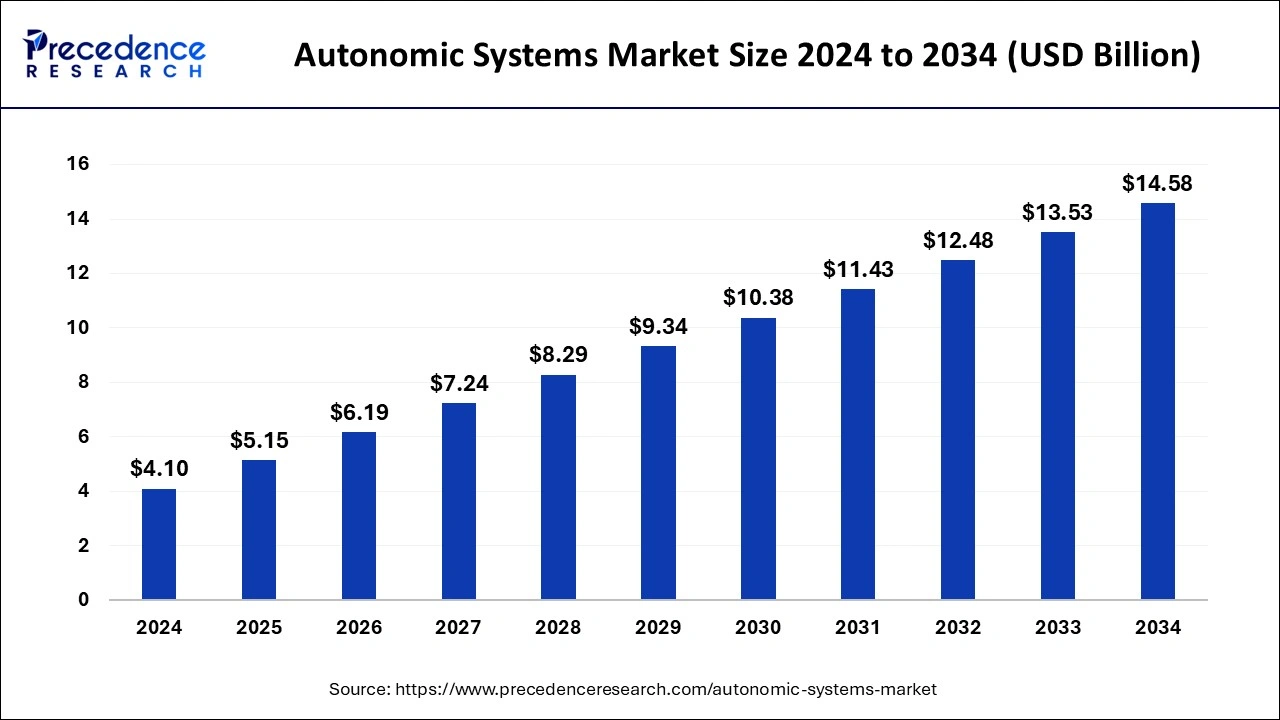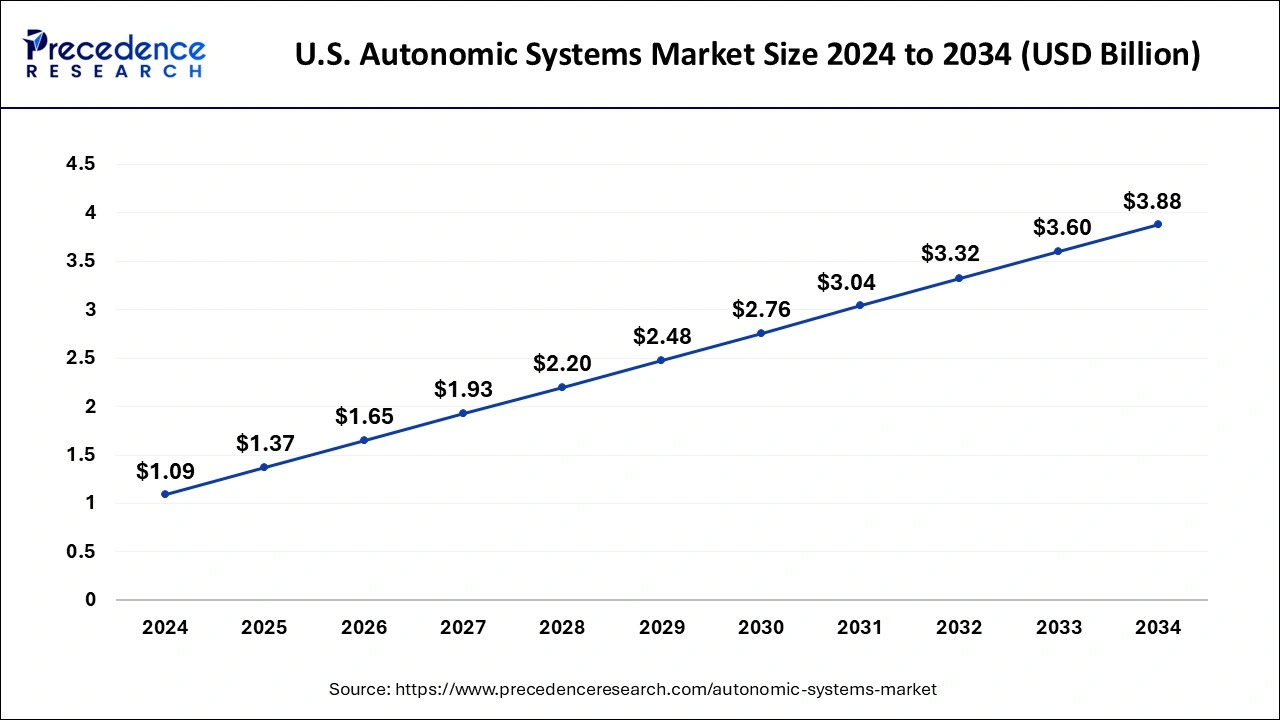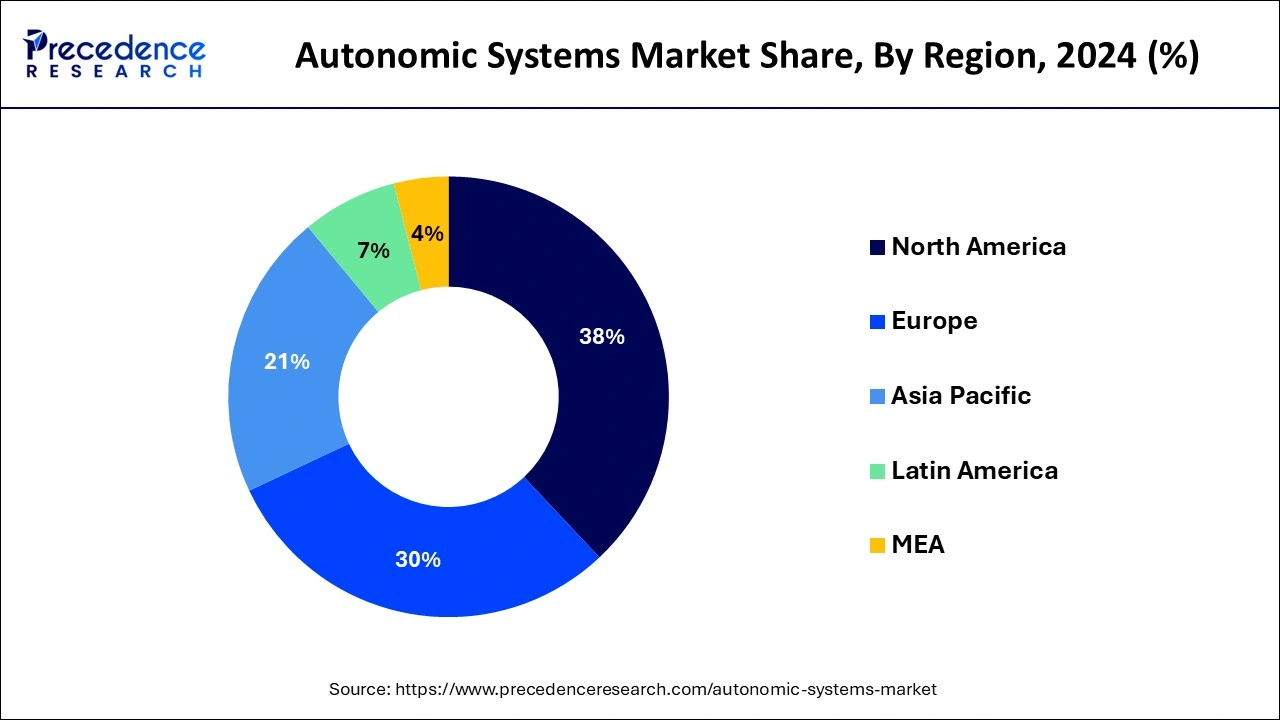April 2025
The global autonomic systems market size is calculated at USD 5.15 billion in 2025 and is forecasted to reach around USD 14.58 billion by 2034, accelerating at a CAGR of 13.53% from 2025 to 2034. The North America autonomic systems market size surpassed USD 1.56 billion in 2024 and is expanding at a CAGR of 13.53% during the forecast period. The market sizing and forecasts are revenue-based (USD Million/Billion), with 2024 as the base year.
The global autonomic systems market size was estimated at USD 4.10 billion in 2024 and is predicted to increase from USD 5.15 billion in 2025 to approximately USD 14.58 billion by 2034, expanding at a CAGR of 13.53% from 2025 to 2034.

The U.S. autonomic systems market size was valued at USD 1.09 billion in 2024 and is projected to hit around USD 3.88 billion by 2034, growing at a CAGR of 13.54% from 2025 to 2034.

North America dominated the autonomic systems market with a 38% market share in 2024. The region hosts a plethora of key players, including technology giants, innovative startups, and established enterprises, which collectively contribute to the market's dynamism and growth. These players bring diverse expertise, cutting-edge technologies, and substantial investments into research and development, fostering innovation and pushing the boundaries of what autonomous systems can achieve. Moreover, North America benefits from continuous technological advancements across various industries, including IT, automotive, healthcare, and manufacturing, among others.
This technological prowess enables the development of sophisticated autonomic systems capable of addressing complex challenges and driving operational efficiencies. Furthermore, supportive government initiatives and policies in North America play a pivotal role in nurturing the growth of the autonomic systems market. Government agencies, research institutions, and industry bodies collaborate to create conducive environments for innovation, entrepreneurship, and the adoption of autonomous technologies.

Asia Pacific is expected to experience significant growth at a CAGR of 18.6% in the forecast period, as the region is witnessing a surge in industrial automation across various sectors, including manufacturing, automotive, and electronics. This trend is driven by the need for increased efficiency, productivity, and cost savings, leading companies to adopt advanced autonomic systems and technologies. Additionally, countries like China and India are emerging as major manufacturing hubs, attracting significant investments in research and development (R&D) and technological innovation. These investments are fueling the development of cutting-edge autonomic systems tailored to the specific needs of industries in the region.
Moreover, Asia Pacific benefits from a large and rapidly growing consumer market, driving demand for autonomous technologies in sectors such as transportation, healthcare, and agriculture. As urbanization and digitization continue to accelerate, there is a growing need for innovative solutions to address the evolving challenges faced by societies and businesses. Furthermore, supportive government policies, initiatives, and incentives aimed at promoting innovation and technology adoption further bolster the growth of the autonomic systems market in Asia Pacific.
The autonomic systems market refers to the segment of the technology industry focused on developing and providing solutions that mimic the self-regulating and self-healing capabilities observed in biological systems. These systems are designed to operate with a degree of autonomy, leveraging artificial intelligence, machine learning, and advanced algorithms to monitor, analyze, and optimize processes without direct human intervention.
In essence, autonomic systems aim to enhance efficiency, reliability, and resilience across various domains, including IT infrastructure management, healthcare, manufacturing, and transportation. The autonomic systems market is a rapidly evolving sector within the technology industry that focuses on creating self-regulating and self-optimizing systems inspired by biological processes.
These systems leverage artificial intelligence, machine learning, and sophisticated algorithms to mimic the autonomous behavior observed in living organisms. Autonomic systems focuses to enhance efficiency, resilience, and adaptability across various domains, including IT infrastructure management, healthcare, manufacturing, and transportation. By harnessing the power of automation and real-time data analysis, autonomic systems can detect anomalies, optimize performance, and make proactive decisions without human intervention.
This capability enables organizations to streamline operations, reduce downtime, improve resource utilization, and mitigate risks more effectively. As the demand for intelligent automation continues to grow, the autonomic systems market is poised for significant expansion, with innovations driving advancements in autonomy, intelligence, and adaptability across diverse industry verticals.
| Report Coverage | Details |
| Growth Rate from 2025 to 2034 | CAGR of 13.53% |
| Market Size in 2025 | USD 5.15 Billion |
| Market Size by 2034 | USD 14.58 Billion |
| Base Year | 2024 |
| Forecast Period | 2025 to 2034 |
| Segments Covered | By Type and By Application |
| Regions Covered | North America, Europe, Asia-Pacific, Latin America, and Middle East & Africa |
Demand for intelligent, adaptive, and self-managing systems
The autonomic systems market is propelled by the imperative need for intelligent, adaptive, and self-managing systems across various industries. In today's fast-paced and dynamic business environment, organizations face increasing complexity in managing their operations, IT infrastructure, and processes. Traditional approaches to system management are often time-consuming, manual, and prone to errors.
As a result, there is a growing demand for autonomic systems that can autonomously adapt to changing conditions, optimize performance, and self-heal in response to disruptions or failures. Intelligent autonomic systems leverage advanced technologies such as artificial intelligence, machine learning, and data analytics to analyze vast amounts of data in real-time.
By continuously monitoring and analyzing system behavior, these systems can identify patterns, detect anomalies, and predict potential issues before they escalate. This proactive approach to system management enables organizations to minimize downtime, improve reliability, and enhance overall operational efficiency. By adapting to evolving business needs and operating conditions, organizations can effectively meet customer demands, improve service levels, and drive competitive advantage. Self-managing autonomic systems are capable of self-configuration, self-optimization, and self-healing without human intervention. These systems can automatically configure settings, fine-tune parameters, and resolve issues in real-time, reducing the burden on IT staff and minimizing the risk of human error.
Self-healing capabilities enable systems to detect faults, isolate problems, and implement corrective actions to maintain system integrity and ensure continuous operation. Therefore, the demand for intelligent, adaptive, and self-managing systems is driving the growth of the autonomic systems market. Organizations are increasingly recognizing the value of autonomic systems in improving operational efficiency, enhancing resilience, and driving innovation. As businesses continue to embrace digital transformation and adopt new technologies, the importance of autonomic systems in enabling agile and responsive operations will only continue to grow.
High implementation costs
The autonomic systems market faces a spectrum of restraints hindering its widespread adoption. One of the hindrances is the complexity of integrating autonomic technologies into existing infrastructures. This process often requires significant investments in time, resources, and expertise to ensure seamless compatibility and functionality. Additionally, the high implementation costs associated with deploying autonomic systems pose a barrier for many organizations, particularly smaller enterprises with limited budgets.
Additionally, Security and privacy concerns also restraint the growth, as the autonomy of these systems raises questions about data protection, unauthorized access, and potential vulnerabilities. Moreover, a lack of awareness and understanding about autonomic technologies among decision-makers and end-users inhibits their acceptance and adoption. Resistance to change within organizations, coupled with ethical and social implications surrounding the use of autonomous systems, further complicates their integration into various industries.
Growing demand for soundproof transportation
The autonomic systems market presents several opportunities for growth and innovation across various industries. One significant opportunity lies in the increasing demand for automation and efficiency in complex systems and processes. Autonomic systems offer the potential to streamline operations, reduce manual intervention, and optimize resource utilization in sectors such as manufacturing, healthcare, transportation, and energy. Furthermore, the proliferation of Internet of Things (IoT) devices and connected technologies creates fertile ground for autonomic systems to thrive. These systems can leverage real-time data from IoT sensors and devices to make intelligent decisions, automate tasks, and improve overall system performance.
Another promising opportunity stems from the rise of artificial intelligence (AI) and machine learning (ML) technologies. Autonomic Systems can harness the power of AI and ML algorithms to continuously learn from data, adapt to changing environments, and enhance their autonomy and decision-making capabilities. Moreover, the increasing focus on sustainability and environmental stewardship presents opportunities for Autonomic Systems to drive efficiencies in resource management, energy consumption, and waste reduction. By autonomously optimizing processes and minimizing environmental impact, these systems can contribute to sustainability goals and promote eco-friendly practices.
Additionally, as industries become increasingly digitized and interconnected, there is a growing need for robust cyber security solutions. Autonomic systems can play a crucial role in enhancing cybersecurity posture by autonomously detecting and mitigating threats, identifying vulnerabilities, and orchestrating response actions in real-time. Hence, the autonomic systems market stands poised for growth as organizations seek innovative solutions to address complex challenges and capitalize on the opportunities presented by digital transformation and automation.
The enterprise software application segment held the largest share of 42% in 2024. The main driver of the enterprise software application segment in the autonomic systems market is its ability to streamline and automate various business processes. Enterprise software applications offer businesses comprehensive solutions for managing their operations, including customer relationship management (CRM), enterprise resource planning (ERP), supply chain management (SCM), and human resource management (HRM). These applications enable companies to enhance efficiency, reduce manual errors, and optimize resource utilization. Hence, the enterprise software application segment plays a crucial role in driving the adoption of autonomic systems by offering sophisticated tools and platforms that enable organizations to achieve higher levels of automation, efficiency, and agility in their operations.
The Information Technology (IT) segment held 29% of the market share in 2024, driven by the need for agility, scalability, and reliability in modern business operations. The autonomic systems market is witnessing significant growth driven by the increasing complexity of IT environments, the demand for efficient IT operations, and the growing importance of cybersecurity. Autonomic systems offer solutions to address these challenges by automating tasks, optimizing resource utilization, and enhancing security measures.
Autonomic systems in the IT segment provide real-time monitoring, analysis, and response capabilities to proactively identify and resolve issues. Additionally, the rising frequency and sophistication of cyber threats have led to an increased focus on cybersecurity, further driving the adoption of autonomic systems. Hence, the Autonomic Systems market is characterized by innovation, strategic partnerships, and investments in research and development to meet the evolving needs of organizations across various industries.
By Type
By Application
By Geography
For inquiries regarding discounts, bulk purchases, or customization requests, please contact us at sales@precedenceresearch.com
No cookie-cutter, only authentic analysis – take the 1st step to become a Precedence Research client
April 2025
January 2025
January 2025
November 2024